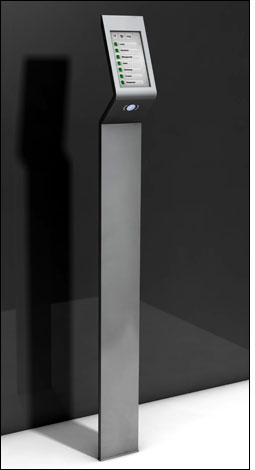Since last month, the 300 employees working at the Capital Bank Plaza office building in Raleigh, N.C., have been using RFID-enabled identification cards to ride elevators. The system, implemented by the building’s owner, Raleigh Development Co. (RDC), allows tenants’ employees to summon an elevator car and be taken to the requested floor without having to press any buttons. The Personal Occupant Requirement Terminal (PORT) destination-dispatch elevator solution was provided by elevator company Schindler.
Every employee is issued a plastic credit-card-sized ID card containing an RFID tag. Upon presenting the card to one of the building’s five RFID terminals, a person is assigned the elevator that could most efficiently transport him or her to the appropriate floor. As a result, says Don Carter, RDC’s owner and principle, the system improves traffic flow throughout the 14-floor building, while also reducing wait times.

When faced years ago with the need to replace electronics and controls on the building’s 40-year-old elevators, Carter says he decided to research the latest technology available that could reduce wait times and make the elevators safer and more efficient, as well as consume less electricity. The building’s elevator renovation project—which also includes video cameras mounted on each elevator, the ability to shut down specific floors during or after hours, and a regenerative drive to draw electricity from the lifts’ movements—utilizes high-frequency (HF) 13.56 MHz passive RFID cards complying with the ISO 15693 standard, to identify a rider and automatically summon an elevator to take that person to his or her preferred floor.
Although RDC researched several solutions, the company selected Schindler’s RFID-based system because the technology seemed more advanced than other offerings, says Nicole Saloio, Schindler’s manager of destination products—and because it could, in the future, allow smartphone users to summon elevators via their mobile phone, using a Bluetooth connection. However, Saloio says, that function is not yet available.
The PORT system, which Schindler launched in the United States in September 2009, is designed to help an individual call for an elevator to a specific floor, and be directed to the car that can most efficiently carry that person to the requested destination. The system, Saloio says, knows where the passenger wants to go before the lift arrives.
According to Saloio, Schindler initially offered an elevator dispatch solution that required a passenger to use a keypad to summon a car, by punching in details regarding the floor to which he was needed, Saloio says. The technology built into the device would then calculate the best elevator for that individual and instruct him, via a display screen, to wait for that specific car. Once the passenger was aboard, the elevator would already be programmed to stop at the requested floor. At a later date, the company launched Schindler ID, an updated version of its dispatch solution that supports either high-frequency (HF) or low-frequency (LF) RFID technology; the updated system has primarily been installed within office buildings, hotels and hospitals. The PORT solution—an upgraded version of the Schindler ID system—includes a larger display screen with a clearer data display, for use in a variety of settings (most commonly, in office buildings and hotels).
A PORT terminal contains a computer, an RFID reader and a 7.4-inch touch screen. Capital Bank Plaza installed five terminals: two on pedestals at the building’s main entrance, two at the elevator bank and one at an entrance adjacent to the facility’s parking area. Schindler designed and provided the hardware, as well as the Schindler ID software that manages the lift assignments and RFID-derived data.
Upon using the card for the first time, workers at Capital Bank Plaza tap their cards near one of the five terminals, and use the touch screen to indicate the floor to which they wish to be taken. The floor requests, along with each card’s ID number, are sent via a wired connection to the Schindler ID software, which assigns an elevator to each user—based on traffic-control patterns designed for that particular building—and forwards that information to the elevator controls.
The terminal’s touch screen then displays the letter (A, B, C or D) of the elevator car that the user has been recommended to ride. Another screen mounted next to the elevator door displays the floors at which that car will be stopping, before those awaiting the lift enter.
The Schindler ID software not only directs an individual to a specific elevator car, but also stores historical data regarding that person’s elevator usage, in order to better direct him or her to the appropriate elevators—a function known as “predictive destination.” For example, if a user repeatedly selects a destination of the 12th floor, the system will assign that individual to an elevator traveling to that floor, informing the rider of that action on the terminal’s touch screen. If the user wishes to go elsewhere, he can override that information and select an alternate floor on the touch screen. If that person changes patterns over a prolonged period of time—such as repeatedly traveling to a different floor—the system will adjust to recommend several floor options when that user presents his card to the PORT terminal. A user may select the “automatic destination” option to have a certain floor assigned every time the card is presented.
According to Carter, since Capital Bank Plaza implemented the system approximately four weeks ago, the lifts have been less crowded, as elevator movement is now being managed by the Schindler system, rather than by the traditional method in which a group of riders with various destinations board the first available car. What’s more, he adds, wait times for elevators have been reduced. One user praised the system for enabling travelers to select and enter an elevator car without ever having to touch anything, he reports, thereby reducing the risk of spreading a contagious disease.
Once Schindler develops a smartphone application, a user may be able to summon an elevator car by tapping his or her mobile phone near a terminal upon entering the building. The system is likely to use a Bluetooth connection, rather than RFID, to accomplish that goal, however.
During the next few months, Schindler expects to implement the system at several high-profile locations, including the Hyatt New Orleans, as well as in two World Trade Center towers, in New York City.



